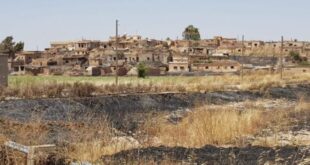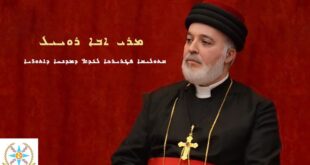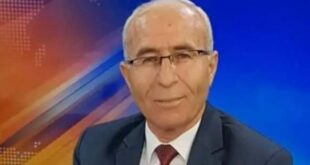AINA) — Assyrian protests against the proposed Iraqi constitution (English, Arabic) have resulted in deadly reprisal attacks against Assyrian Christian civilians by forces loyal to Masoud Barazani, the tribal chieftain of the Kurdistan Democratic Party (KDP). On August 24, several hundred Assyrian (also known as Chaldean and Syriac) protestors demonstrated in the two Northern Iraqi Christian towns of Qaraqosh (Bakhdeda) and Telsqof (Tel-sqeepa) against the constitution’s splintering of the Assyrian Christian community into separate groups identified as either Assyrian or Chaldean. The Assyrian community in Iraq had previously been referred to singly as “ChaldoAssyrian” in the Transitional Administrative Law (TAL, English, Arabic) to reflect the community’s desire to be recognized as one.The demonstrations was also intended to send a strong signal of opposition to KDP’s continued illegal expansion into Assyrian areas.
Two days later, the KDP struck back with deadly force. On August 26 37 year old Nabil Akram Ammona, a resident of Bartilla, was shot twice in the head by KDP paramilitaries while filling his automobile with gasoline (AINA, 8-27-2005). A group of armed KDP security wearing Iraqi National Guard (ING) emblems drove up to Mr. Amona and forcibly took away the gas nozzle he was using. A bewildered and irritated Mr. Amona protested. Instantly, one of the KDP thugs fired two shots execution style into Mr. Amona’s head.Mr. Amona died instantly as he slumped into a pool of his own blood.
Local residents were shocked and terrified. Only one, Mr. Mattai Shamoun Zora Sha’ya rushed over to assist and comfort Mr. Amona. The moment he approached, the same Kurd shot Mr. Sha’ya twice in the head as well. Mr. Sha’ya, a father of four, is the nephew of the Syriac Orthodox Bishop of Mar Matti Monastery and is currently in critical condition. He is not expected to survive.
Eyewitnesses at the scene reported that the assailants spoke Kurdish. The same KDP attackers were previously known to have stolen gasoline from the same station for later sale on the black market for their own personal gain. Previous attempts by Assyrian Christians to appeal to the occupying KDP leaders have gone unheeded and unanswered.
In recent weeks, the KDP has stepped up a systematic terror campaign against the Shabak and Assyrian Christian residents of the Nineveh Plain. Numerous civilians have been kidnapped for no apparent reason other than to sew fear. Such “arrests” as they have been termed by the KDP occupying powers are widely believed to be used by the KDP to terrorize the local population into not resisting further expansion of the KDP’s occupation of non-Kurdish areas. On August 19, Bartilla resident Mr. Sahir Ibrahim Shamoun was likewise “arrested” and beaten in the head senseless by KDP thugs using the butt of their pistols. Mr. Shamoun remains in a coma.
The recent Assyrian demonstration was viewed by the KDP as especially provocative. The KDP has sought to divide the Christians of Iraq into competing, demographically insignificant communities. According to one observer, “the pro unity demonstration must have struck a nerve.” Placards held by the demonstrators revealed a wide ranging representation from the towns of the Nineveh Plain. Some signs read “Chaldean+Syriac+Assyrian=1, the Augin Manna Academic Center,” while others read “Assyrian Women’s Union, TelKaif district” and Assyrian women’s Union., Town of Ain Sifni.” Almost immediately, the KDP leadership mobilized to blunt a potentially explosive situation. It is widely believed by residents in the towns of the Nineveh Plain that the recent murders are directly related to the protests of August 24. It is believed that KDP leaders called for “shaking up” the Christians in the immediate aftermath of the demonstration.
The KDP also coerced the mayor of Telsqof as well as the priest of Mar Gewargis Church in Telsqof to sign a letter denouncing the protestors as agitators who did not represent the will of the town. The letter was reminiscent of an earlier, similar letter ordered by the KDP that was signed by several Assyrian village leaders in the Nahla region following a series of midnight raids by KDP paramilitaries (AINA, 10-16-1999). That letter denying any attacks by the KDP later proved embarrassing to the KDP when the attacks were confirmed by the United Nations (UN) as well as the International Committee of the Red Cross (ICRC).
The threats reached as high up as the Chaldean Patriarch, Mar Emmanuel Delly.Under what is widely believed to be direct threat, the Chaldean Patriarch was quoted as criticizing those advocating a single designation for Iraq’s Christians by saying that combining the Chaldean and Assyrian names was “a joke in front of other nations.” His statement, given soon after the demonstration, was in marked contrast to earlier statements made before the most recent KDP threats and murders. In a January 22nd of 2005 statement (signatories), the Patriarch had said “We the Christians “ChaldoAssyrians” of Syriac culture and language are sons of this country from distant ages work with our brothers, the Moslems, Yazidis, and Mandeans as one hand and one heart for the advancement and progress of Iraq.”
Threats by the KDP to dissidents against the occupation amount to a real danger. Eight days before the Assyrian Christian demonstration, several hundred Shabak demonstrators similarly protesting KDP policies were fired upon by an armed KDP gang (AINA, 8-16-2005). Several people were seriously injured in the attack on a peaceful, government approved, demonstration. Assyrian Christians, Yezidis, Turkoman, Shabak, and Arabs have been similarly targeted by the KDP in an increasingly violent push to consolidate non-Kurdish areas into a greater Kurdish occupied region of northern Iraq.
Following the fall of the Baathist regime, the Assyrian Democratic Organization (ADO) and the Assyrian Democratic Movement (ADM) cosponsored the Chaldean Syriac Assyrian Conference in Baghdad during October, 2003. The two most important points of agreement that emerged from the conference were the consensus decision by all of the communities to legally refer to the “Chaldean Syriac Assyrian” people collectively as “ChaldoAssyrian,” and to demand the establishment of an Assyrian self-administered area in the Nineveh Plain. Through perseverance, both points were incorporated into the TAL, with article 53D guaranteeing administrative rights for ChaldoAssyrians. As one Assyrian leader noted “Since that time, the KDP has relentlessly sought to make sure the limited gains in the TAL are never incorporated into the new Constitution.”
The increasing KDP violence has served to bring Assyrians, Yezidis, Turkman, Shabak, and Arabs closer together in their resistance to Kurdish hegemony. However, The KDP push to legally marginalize these communities in the proposed Constitution (AINA, 8-24-2005) as well as violently repress dissent through murder has also served to disillusion non-Kurdish communities with the democratic process. One analyst labeled the Kurdish view of democracy as “‘gun barrel democracy’ that was at times partly responsible for fueling the ongoing insurgency.”For Assyrian Christians still reeling from murders, kidnappings, rapes, and land grabs, the increasingly dangerous outlook in Iraq has even more clearly reinforced the absolute need for an administered area to serve as a safe haven or sanctuary in northern Iraq.
 Assyrian Democratic Organization ADO
Assyrian Democratic Organization ADO






